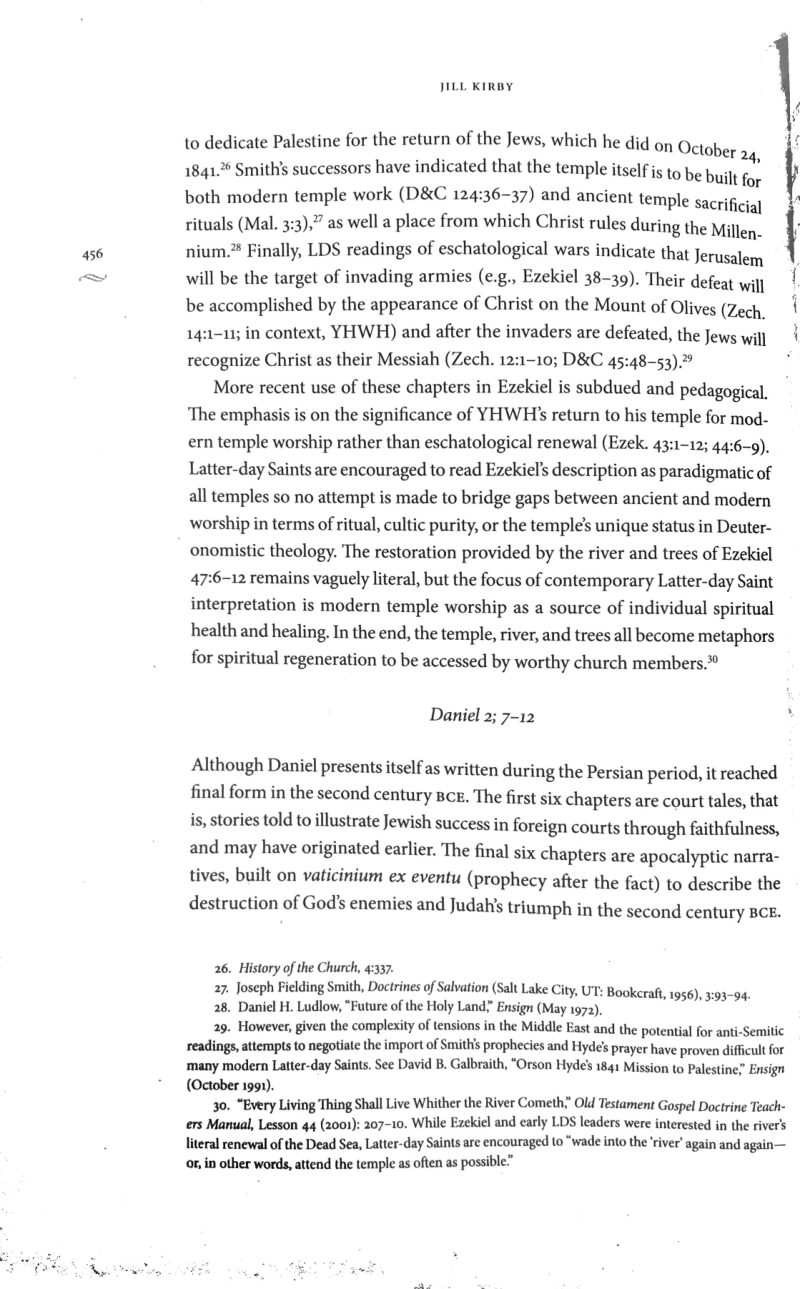Jill Kirby discusses Daniel 7; writes that, in original context, the Ancient of Days is God the Father; Joseph reappropriated Daniel 7 in teaching the Ancient of Days is Adam/Michael.
- Type
- Book
- Source
- Jill Kirby LDS
- Hearsay
- Direct
- Reference
Jill Kirby, “Apocalyptic Literature,” in The Bible and the Latter-day Saint Tradition, ed. Taylor G. Petrey, Cory Crawford, and Eric A. Eliason (Salt Lake City: The University of Utah Press, 2023), 456-58
- Scribe/Publisher
- University of Utah Press
- People
- Jill Kirby
- Audience
- Reading Public
- Transcription
Daniel 2; 7-12
Although Daniel presents itself as written during the Persian period, it reached final form in the second century BCE. The first six chapters are court tales, that is, stories told to illustrate Jewish success in foreign courts through faithfulness, and may have originated earlier. The final six chapters are apocalyptic narratives, built on vaticinium ex eventu (prophecy after the fact) to describe the destruction of God’s enemies and Judah’s triumph in the second century BCE.
Among most Latter-day Saints, however, Daniel is considered a sixth century BCE prophet serving in the Babylonian court of is visions are read Christologically and eschatologically. Application to events of the second century BCE is affirmed, but most events are persons are read as multiple fulfillment prophecy or types. Daniel 2 and 7, both historical apocalypses, are by far the most prominent chapters but Daniel 7 has a unique reading among LDS interpreters that shifts the scenario from a judgment scene in the divine throne room to an eschatological gathering to welcome and receive Christ at his Second Coming.
Daniel 7 opens as Daniel sees a succession of grotesque beats coming out of the sea. The fourth beast is distinguished from the others by ten horns, three of which are pulled up to allow a particularly offensive “little horn” (v8) to grow. The scene then abruptly shifts from earth to the heavenly court room for judgment. God (the Ancient of days, Dan. 7:9 KJV) takes his place on the heavenly throne, destroys the beast and its horn, then renders judgment in favor of a human figure (“one like the Son of man; Dan. 7:12 KJV). In context, the beasts are the ancient kingdoms of Babylon, Media, Persia, and Greece. The “little horn” is Antiochus Epiphanes IV, whom the Jews had to serve for three and a half years. When God renders judgment, Antiochus Epiphanes IV is destroyed while the Jews prevail over their enemies to receive the lasting kingdom.
Readings of this passage amongst most LDS leaders follow the common Christological interpretation in some details: the “one like a Son of man” is Christ and the “little horn” is one of many anti-Christ figures in LDS reception (the beast from the sea [Rev. 13:1], Gog [Ezek. 38:14-23], Sherem [Jacob 7:1-24], Korihor [Alma 30:6-60], and possibly the “great and abominable church” [1 Ne. 22:13-18]). However, Smith’s identification of the “Ancient of days” as Adam, rather than God, sets up a radically different scenario in which the heavenly court becomes a culminating reunion.
Smith’s reading of Daniel 7:9-14 draws on two other texts. The first is Daniel 12:1-3, in which Michael, identified with Adam in the LDS tradition, stands with Israel as its protector. The second is the expanded LDS version of the primeval history (Gen. 1-11) in Moses 3-7, which establishes that Adam presided over a dispensation. In Doctrine and Covenants 107:53-56, Joseph Smith reported that just before Adam’s death he summoned his righteous descendants to the “valley of Adam-ondi-Ahman,” during which he blessed them and reported his own apocalyptic vision. At the climax of this event, Christ appeared and validated Adam’s royal and priestly status. According to Joseph Smith, this family gathering is to be reprised as Adam’s righteous descendants, both living and dead, will return to the same location, identified as Spring Hill, near Gallatin, Mo. In this reading, Adam (Michael), how is the oldest man (Ancient of Days, Dan. 7:9 KJV) functions as a royal priest: seated on a fiery throne, his sons will return their priesthood keys to him, and he will return them to Christ (one like a Son of man; Dan. 7:12 KJV), who holds them by right and will personally rule during the Millennium.
- Citations in Mormonr Qnas
The B. H. Roberts Foundation is not owned by, operated by, or affiliated with the Church of Jesus Christ of Latter-day Saints.

